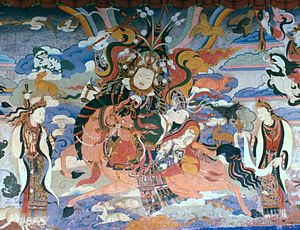
Back Gezər xan Azerbaijani གེ་སར་རྒྱལ་པོ། Tibetan Гэсэр BXR El rei Gesar Catalan Gesar Czech Epic of King Gesar DAG Gesar German El rey Gesar Spanish حماسه گسار خان Persian Épopée du roi Gesar French
This article may require copy editing for grammar, style, cohesion, tone, or spelling. (March 2024) |

The Epic of King Gesar (Tibetan: གླིང་གེ་སར།, Wylie: gling ge sar), also spelled Kesar (/ˈkɛzər, ˈkɛs-/) or Geser (especially in Mongolian contexts), is an epic from Tibet and Central Asia. It originally developed between 200 or 300 BCE and about 600 CE. Following this, folk balladeers continued to pass on the story orally; this enriched the plot and embellished the language. The story reached its final form and height of popularity in the early 12th century.
The epic relates the heroic deeds of the culture hero Gesar,[1] the fearless lord of the legendary kingdom of Ling (Wylie: gling). It is recorded variously in poetry and prose, through oral poetry performance, [2] and is sung widely throughout Central Asia and South Asia. Its classic version is found in central Tibet.[3]
Some 100 bards of this epic (Wylie: sgrung, "tale")[4] are still active today in the Gesar belt of China.[5] Tibetan, Mongolian, Buryat, Balti, Ladakhi, and Monguor singers maintain the oral tradition, and the epic has attracted intense scholarly curiosity as one of the few oral epic traditions to survive as a performing art. Yugur[6] and Salar[7] versions of the epic are also recorded among the Balti of Baltistan, the Burusho people of Hunza and Gilgit,[6] and the Kalmyk and Ladakhi people[8][9] in Nepal, and among various Altai, Turkic, and Tungus tribes.[10] The first printed version was a Mongolian text published in Beijing in 1716.[11]
There is a very large body of versions, each with many variants, reputed by some to be the longest in the world.[4] Although there is no one definitive text, the Chinese compilation of its Tibetan versions so far has filled some 120 volumes; it consists of more than one million verses[4] divided into 29 "chapters".[12] Western calculations speak of more than 50 different books edited so far in China, India, and Tibet.[4]
- ^ Samuel 1993, pp. 68–9.
- ^ Samuel 2005, p. 166.
- ^ Chadwick & Chadwick 1940, pp. 48–9, 215–6.
- ^ a b c d Maconi 2004, p. 372.
- ^ Jiàngbiān Jiācuò 1998, p. 222.
- ^ a b Maconi 2004, p. 373.
- ^ Dwyer 2007, pp. 75–76.
- ^ Penick 2009, p. vii.
- ^ Herrmann 1990, p. 485.
- ^ Harvilahti 1996, p. 40.
- ^ Harvilahti 1996, p. 43.
- ^ Harvilahti 1996, p. 42.
© MMXXIII Rich X Search. We shall prevail. All rights reserved. Rich X Search